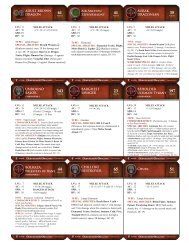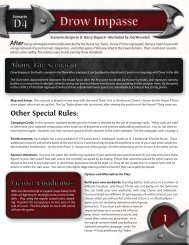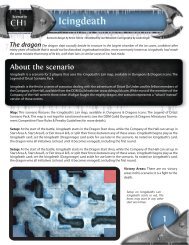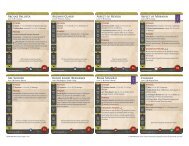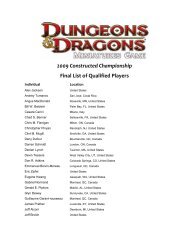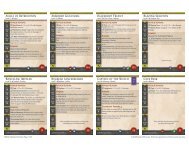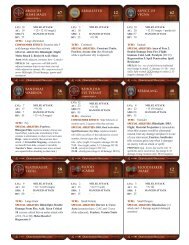You also want an ePaper? Increase the reach of your titles
YUMPU automatically turns print PDFs into web optimized ePapers that Google loves.
GLOSSARY<br />
This glossary explains game terms (usually in bold text the first time they appear in the<br />
<strong>rules</strong>), as well as keywords that appear on stat cards. It contains detailed information on<br />
certain special abilities that are too complex to explain on the stat cards, as well as entries and<br />
occasional explanatory notes for abilities that formerly appeared only on stat cards.<br />
Some entries are special abilities that appear only on stat cards. These have “reminder text”<br />
in parentheses following the entry but are not further explained. Any clarification of the rule<br />
appears in italics.<br />
GUIDELINES TO READING ENTRIES<br />
This glossary uses a few shorthand terms.<br />
[#]: This represents a variable numerical value. For example, “Conceal [#]” describes the<br />
Conceal ability but assigns no particular number to it. A given creature has a specific Conceal<br />
rating, such as Conceal 6.<br />
CAPITALS: A capitalized word, such as “CREATURE” or “ENERGY,” stands for a variable<br />
entry. Thus, “Immune ENERGY” means that the creature takes no damage from a given type<br />
of energy but does not specify the energy type. A Green Dragon, for example, has Immune<br />
Acid.<br />
: Many special abilities, most spells, and even some attacks can be used only a limited<br />
number of times during a skirmish, represented by check boxes (). Each check box allows<br />
one use. If a limited-use ability requires a successful attack, such as the Inspired Lieutenant’s<br />
Smite ability, then the acting player declares the use of the ability before making the attack<br />
roll. A miss counts as one use of the special ability just as a hit does.<br />
In an entry, “this creature” refers to the creature using the special ability or casting<br />
the spell.<br />
DEFINITIONS<br />
The following terms are listed in alphabetical order.<br />
Aberration: A type of creature.<br />
AC: Armor Class. A number representing a creature’s ability to avoid being hit by an attack.<br />
See page 5.<br />
acid: (Keyword) A type of energy.<br />
acting: The acting creature is the creature that is currently moving, attacking or producing an<br />
effect. The acting player is the player whose warband that creature belongs to.<br />
Usually the acting creature is the creature that is taking its turn, but in cases such as attacks<br />
of opportunity or routing, creatures act out of turn.<br />
activate: When you activate one of your creatures, that creature takes its turn for the round. See<br />
Activate Creatures on page 9.<br />
active: An active creature is not routing, stunned, asleep, paralyzed, or helpless.<br />
adjacent: Occupying a square next to this space (including diagonally). A creature is not<br />
adjacent to creatures behind walls.<br />
ally/allied creature: Allies are other creatures in the same warband or in teammates’ warbands.<br />
Almighty: This creature can’t be affected by spells cast by other creatures in its own or its allies’<br />
warbands. This includes both offensive spells such as fireball and defensive spells such as<br />
shield of faith.<br />
Animal: A type of creature.<br />
31



